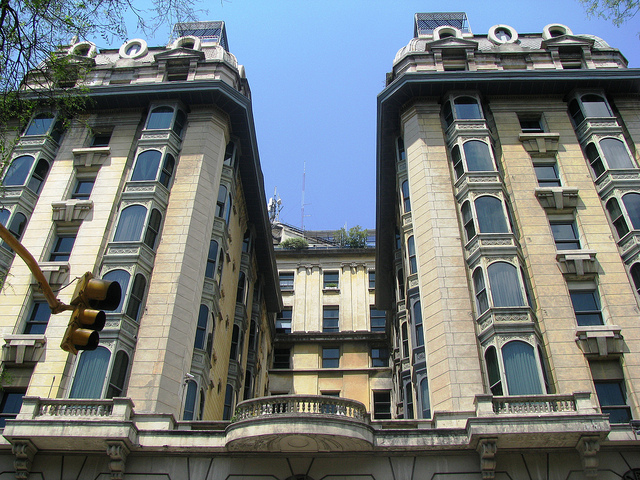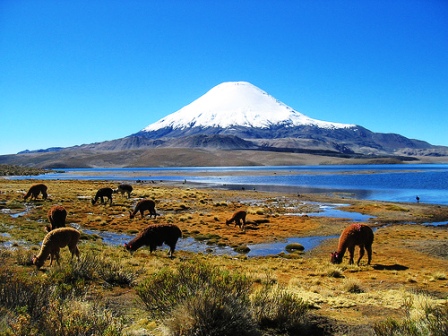Argentina’s capital is known for its impressive architecture. Part II of this article series features five more architecturally significant areas that I got to explore first hand during my November 2011 trip to Buenos Aires.
The Retiro Train Station:
Inaugurated in 1915, the Retiro Train Station (Estación Retiro) consists of three separate railway terminals . The most impressive is the British-designed Retiro Mitre station with its French-style cupola and English steel framework. The main bus station of Buenos Aires is adjacent to the Retiro Train Station and just around the corner is a slum area called Villa 31 that you see when you depart on one of the buses from the terminal. Locals advised me to stay clear of Villa 31 and safety precautions against pickpocketing are strongly advised inside the train station.

Plaza San Martin:
This distinguished public square holds several landmarks of Buenos Aires. The Edificio Cavanagh, a residential apartment block from the 1930s with a distinctive setback design, anchors the square on the east side. A large green space in the centre is home to the Monumento a los Caídos en Malvinas, honouring the fallen soldiers of the Falklands War. The Torre de los Ingleses was gifted to Buenos Aires by the city’s expatriate community. The Circulo Militar on the west side was originally a private mansion of a wealthy family and was completed in 1914. It is modelled after some of the castles in France’s Loire Valley. Another impressive building is the Marriott Plaza Hotel Buenos Aires which was opened in 1909 as the Plaza hotel, Argentina’s first luxury hotel. It has hosted dignitaries such as Charles de Gaulle, Theodore Roosevelt, Indira Ghandi, King Juan Carlos of Spain as well as Luciano Pavarotti. Several more impressive buildings surround the square: the Palacio Haedo, the Palacio San Martin and the Centro Naval. An equestrian statue of General José de San Martín was commissioned in 1862 to celebrate the Argentine independence fighter. Calle Florida, the city’s most famous street, starts at the southwest corner of the square.

Plaza Lavalle
This three-block leafy square is dedicated to Juan Lavalle, one of Argentina’s liberation heroes. The two most important buildings on this public space are the Palace of Justice, location of Argentina’s supreme court, and the famous Teatro Colón, known as one of the best opera theatres in the world. The Mirador Massue, a 1909 Art Nouveau building at the corner of Talcahuano and Tucuman, is considered to be one of the city’s most beautiful buildings. The Central Synagogue of Buenos Aires is also located on the Plaza Lavalle. The centre of the square features large palm trees and ceiba trees with their stunning red blossoms.

San Telmo
One of the oldest districts of Buenos Aires, San Telmo was actually where the first European explorer made landfall in 1536. For about three centuries, from the 1500s to the 1800s, this was the area where the colonial officials resided. A cholera epidemic in 1871 claimed more than 10,000 victims, and from that point forward many of the residents fled northwards into districts such as Barrio Norte and further north. As a result, many incoming European immigrants made this area their home. San Telmo’s bohemian vibe has made it a popular tourist destination and a center of tango. One of the most famous destinations in this neighbourhood is the Plaza Dorrego, the second oldest square in the city, which is most lively on weekends when it features an antique market and live tango dancing.

La Boca
La Boca is one of Buenos Aires’ most iconic areas. With its characteristic colourful houses, this area has become one of the city’s most important tourist destinations, and many would call it an outright tourist trap. The area was originally settled between about 1880 and 1930, when roughly 6 million immigrants, mostly from Italy and Spain, landed in the port of La Boca. Many of them stayed right in the area and painted their modest homes with leftover paint from the shipyard. The most well-known part of La Boca is El Caminito , which is full of restaurants, souvenir shops and live tango shows. I went there on a Sunday, sat down for lunch, and was able to watch an impressive tango and Argentine folk dance show, all included in the price of a very affordable meal. It’s a great place for people watching.





